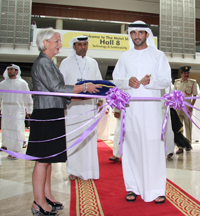|
Totting up the figures, event organizers IIR calculated that there was an overall growth in attendance of 23 per cent on last year’s show in Budapest, with almost 3000 visitors coming from 84 countries. A total of 106 exhibitors – complemented by presentations and case studies delivered by a roster of expert speakers – gave a wide range of insights into the future evolutionary path for critical communications as well as current best practice. “We’ve had a fantastic year in TETRA”, commented a delighted Phil Kidner, chief executive of the TETRA and Critical Communications Association. “We’ve had more TETRA terminals shipped in the past year than at any time ever. There’s between two and three million terminals being used today, as we speak, around the world – which, compared to GSM, is a trivial number, but compared to any other PMR technology it’s a very significant number. And that’s something like a 9–10 per cent increase over Predicting another record-breaking year ahead, Mr Kidner added: “We’ve also seen in the last 12 months significant advances in North America. Contracts have now been awarded in both Canada and the US, so for the first time ever TETRA is available in North America.” Growth areasWhile Europe continues to account for most product shipments, the main growth in TETRA in the past year occurred elsewhere. “Europe is acting as a mature market now and often a replacement market”, observed Thomas Lynch, of the independent analysts IMS Research, at a round-table meeting organized by Motorola. “The fastest-growing market was the Middle East and Africa, with a significant growth of more than 70 per cent. And then we’re seeing Latin America: things like the World Cup driving this, and the Olympics, in Brazil. But there are other parts of Latin America that have taken up TETRA technologies.” Shipments of terminals totalled almost half a million in 2011, he continued. “We’re projecting this to increase, and in 2016 it’s going to be over 600?000 shipments. Now, what’s significant here is that this technology is growing. Shipments of TETRA devices are growing, and the TETRA market is here to stay.” Building a broadband futureAs always when two or more TETRA experts are gathered together, two main themes of discussions at the show revolved around the impact of broadband – and specifically the impact that the decision to use LTE will have – as well as the continuing national and international debates about spectrum availability and regulation. Many conversations at the show and its surrounding social events reflected this focus. With a consensus now established that LTE, with PMR-oriented modifications, will be the future broadband technology for critical communications users worldwide, several exhibitors were already demonstrating LTE equipment on their stands. “This is a technology which will be able to deliver several tens of megabits from the field to the police cars, to Metro users, to the utility people”, said Philippe Agard, of Alcatel-Lucent, which launched an LTE collaboration with Cassidian at last year’s congress. “It’s a technology which is open and flexible, it is a standard-based technology and it is all-flat IP architecture, so it’s easy to extend networks because you can converge all your infrastructure on an IP platform.” At the 2012 congress, the two companies presented a working, end-to-end TETRA-LTE system. “This is a solution that we have jointly introduced with Cassidian to the market today, a solution which is available for the community”, M. Agard continued. “Cassidian is going to develop the terminals for this market. It’s also working on all the applications to leverage the broadband network. “On the Alcatel side, what we provide is our LTE platform – a platform which is already well deployed... with over 20?000 eNodeBs [LTE base stations] already shipped to the market. So this is a very robust platform.” M. Agard highlighted three features of the platform: with data capabilities an order of magnitude faster than TEDS can provide, it can meet the broadband data needs of the public safety community;
|

 Dubai currently seems to be cornering the world market in superlatives. Whether it’s the world’s tallest building or the largest shopping mall on the planet, this city-state seems to have a talent for pushing engineering and architecture to its limits. Judging by the buzz at this year’s
Dubai currently seems to be cornering the world market in superlatives. Whether it’s the world’s tallest building or the largest shopping mall on the planet, this city-state seems to have a talent for pushing engineering and architecture to its limits. Judging by the buzz at this year’s